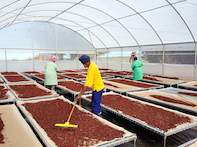
Agulhas Honeybush Tea follows the processing of Honeybush Tea that occurs in five distinct phases which are harvesting, cutting, fermentation, drying and sieving.
During harvesting, the farmer workers harvest the Honeybush Tea either by pruning shears or pruning sickles. The tea stems, of both the Fermented Tea and the Green Tea, are then tied up in bundles, weighed and moved to processing facilities.
After harvesting, the process of cutting begins where the tea stems that have been moved to the processing facilities are cut into approximately 1-5mm pieces. They are separated according to different cut sizes. From here on, the processing of Fermented Honeybush Tea and Green Honeybush Tea differs.
For the regular Fermented Honeybush Tea process, freshly chopped raw plant material is placed in large stainless steel fermentation tanks. Sometimes pure fountain water is added inside these tanks to initiate the fermentation process. These tanks are rotated four times per day to ensure the entire batch of tea has contact with oxygen.
The tea is heated to approximately 70˚C where it is monitored for about 60 hours until it’s taken out of the tanks and naturally dried in the greenhouses. During fermentation, the colour of the plant material changes from green to brown. For the Green Honeybush tea process, the batch of tea is chopped and dried in the greenhouses because it doesn’t undergo a fermentation process.
Once the fermentation and drying phases have been completed, sieving begins where both the Fermented and Green Teas are sieved into three different cuts: tea dust, fine cut and coarse cut. The teas are then packaged according to the tea (Fermented or Green Honeybush Tea) and cut types which are packaged in bulk or in re-sealable pouches and sold.
 Honeybush is the name of an indigenous fynbos shrub in South Africa. The plant is a member of the Fabaceae (Leguminosae) family and has yell...
Honeybush is the name of an indigenous fynbos shrub in South Africa. The plant is a member of the Fabaceae (Leguminosae) family and has yell...